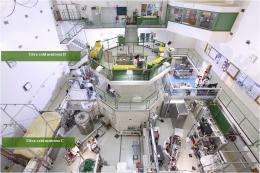Solving the mysteries of astrophysics: Ultracold neutrons

Scientists at Johannes Gutenberg University Mainz (JGU, Germany) have built what is currently the strongest source of ultracold neutrons. Ultracold neutrons (UCNs) were first generated here five years ago. They are much slower than thermal neutrons and are characterized by the fact that they can be stored in special containers. This property makes them important tools for experiments to investigate why matter dominates over antimatter in our universe and how the lightest elements were created directly after the Big Bang. "We have commissioned a new UCN source and improved the overall procedure so that we can now generate and store considerably more ultracold neutrons than before and more than anybody else," says Professor Werner Heil of the Institute of Physics at Mainz University. Having so far managed to achieve a density of ten UCN per cubic centimeter, the Mainz research team of chemists and physicists has become one of the global leaders in this research field.
In 2006, the Mainz team, working in cooperation with the Technical University of Munich, produced for the first time ultracold neutrons using the pulsed Mainz TRIGA reactor. Neutrons are created by means of nuclear fission in the TRIGA research reactor in Mainz. These fission neutrons reach speeds up to 30,000 kilometers per second – a tenth of the speed of light. Interaction with light atomic nuclei in the reactor slows them down to a 'thermal' speed of approximately 2,200 meters per second. The apparatus developed by the researchers from Mainz University is then employed: a three meter long tube is inserted in the beam tube of the reactor at the point where there is the highest flux of thermal neutrons. The thermal neutrons undergo extreme velocity deceleration in this tube.
This new source of UCNs in beam tube D of the Mainz TRIGA reactor has just successfully completed its first stress test. In the UCN apparatus the thermal neutrons are slowed down in two in two steps: first with hydrogen and thereafter with an ice block made of deuterium at minus 270 degrees Celsius. "The neutrons are now so slow that we could run after them," says Professor Werner Heil. The UCNs move to the experimental site at the other end of the tube at a speed of only 5 meters per second. The stainless steel tube is coated inside with nickel to ensure that no neutrons are lost on the way.
The key parameter for the scientists is the UCN density that can be achieved at the site of the experiment – a prerequisite to perform high-precision experiments. "In our first trial, we achieved ten UCN per cubic centimeter in a typical storage volume of ten liters. When we use hydrogen as a pre-moderator and make a few minor changes, we expect fifty UCN per cubic centimeter," explain Dr Thorsten Lauer and Dr Yuri Sobolev, who supervise the system. This is more than sufficient to perform experiments such as measurements to determine the life time of the neutron. With this UCN density, the Mainz research team is now the front-runner in the race to achieve the highest storage density, in which facilities in Los Alamos, Grenoble, Munich and the Swiss city of Villigen are competing.
The life time of a neutron – according to current scientific findings – is approximately 885 seconds, but this number is dominated by systematic errors. The method employed is known as "counting the survivors": the number of neutrons left after a certain decay time is correlated with the known initial number in the sample. Till now, for more precise life time measurements not enough ultracold neutrons were available.
More information: I. Altarev, et al: Neutron velocity distribution from a superthermal solid 2H2 ultracold neutron source. The European Physical Journal A 37 (2008) 9.
A. Frei, et al: First production of ultracold neutrons with a solid deuterium source at the pulsed reactor TRIGA Mainz. The European Physical Journal A 34 (2007) 119.
Provided by Johannes Gutenberg University

















